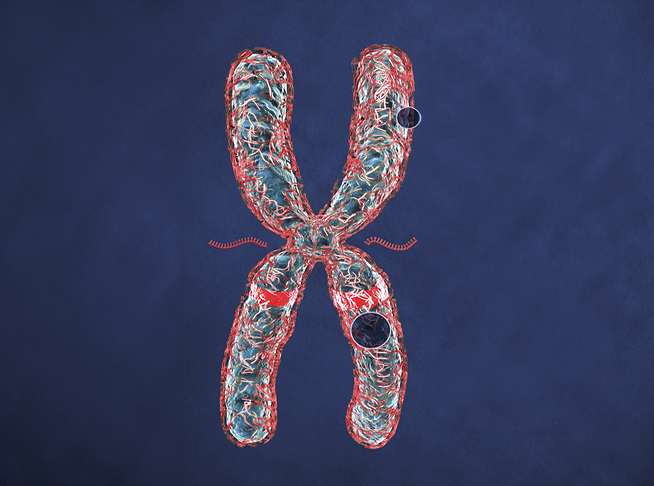The Hidden Role of the Silent X Chromosome in Brain Health
A new study reveals that despite being silenced, the "extra" X chromosome in females is actually partially active — and may play a role in protecting the brain from age-related changes.

29 September 2025
|

5 minutes
|
It has long been known that females, including humans, tend to live longer than males, even under extreme conditions such as famine and pandemics. Studies show that the female tends to maintain a younger metabolic age than the male brain throughout the adult life span. This has been observed in studies examining age-related changes in cognitive function as well as how brain cells consume sugar and oxygen in old age. The reasons behind these differences remain unclear, and researchers around the world are actively investigating the phenomenon. Understanding it could one day lead to new treatments for age-related health problems and possibly even extend human life expectancy.
One key biological difference between males and females lies in their sex chromosomes: males typically have one X and one Y chromosome, while females have two X chromosomes. To balance gene expression, one of the X chromosomes in each female cell is largely silenced — a process known as X-inactivation that has been studied extensively. A recently published study examined the partial activity of the inactive X chromosome as a potential contributor to differences in brain function between aging men and women. The findings suggest that this partial activity may play a meaningful role in female brain aging and could help protect the female brain from age-related decline.

Male cells typically have one X and one Y chromosome, while female cells have two X chromosomes. Twenty-three pairs of human chromosomes | Alfred Pasieka / Science Photo Library
Silent Chromosomes Run Deep
Inside every cell of the body lies DNA – the genetic blueprint that defines all living organisms. DNA directs the production of RNA and proteins, which govern how cells function and, ultimately, how the body operates. DNA is packaged into structures called chromosomes, arranged in 23 pairs. One of these pairs consists of the sex chromosomes, which determine biological sex: females typically have two copies of the X chromosome, while males have one X and one Y.
A mechanism called X chromosome inactivation helps balance the activity of the two X chromosomes in females, preventing them from becoming overly active. As part of this process, a non-coding RNA molecule called Xist (X-inactive specific transcript) is produced from one of the X chromosomes. Xist coats the same chromosome it originates from, effectively silencing it and preventing it from being active within the cell. The exact mechanism by which a cell determines which X chromosome to inactivate remains unclear, though current evidence suggests the choice is random in each female cell. However, research has shown that this process is more complex than previously thought in some cases, even after inactivation, specific regions of the silenced X chromosome can escape suppression and remain active.

An RNA molecule called Xist is produced from one of the X chromosomes, coats it, and silences its expression within the cell. X chromosome inactivation | Source: Nicolle R. Fuller / Science Photo Library
The Right Chromosome in the Right Place
In a new study published in Science Advances, a team of researchers aimed to explore whether partial activity of the inactivated X chromosome is linked to the preservation of cognitive function in older women—a phenomenon previously observed in other studies. To test this hypothesis, they used mice from two different subspecies. These subspecies are genetically distinct enough for their DNA to be clearly distinguishable, yet similar enough to produce viable offspring when crossbred.
The researchers crossbred mice from the two subspecies to clearly identify the origin of the genes expressed in the female offspring’s cells—specifically, whether a given gene came from the X chromosome of one subspecies or the other. To control which X chromosome would be active, they introduced a mutation into the DNA of one of the parent mice. This mutation prevented the production of the Xist molecule and, consequently, the inactivation process it triggers. As a result, the X chromosome from the non-mutated parent was always the one to be silenced. This setup allowed the researchers to know in advance which X chromosome would remain active in the offspring’s cells.
Together, these two strategies allowed the researchers to control which X chromosome was silenced and to track gene expression from both the silenced and active chromosomes.

By crossbreeding mice from two distinct subspecies, researchers were able to trace the origin of genes expressed in the female offspring’s cells. Laboratory mice | unoL, Shutterstock
Silenced but Active
With the ability to control which X chromosome was active or silenced, the researchers next investigated whether the inactivated X chromosome could still contribute to the production of unique proteins in older female mice. To explore this, they compared brain cells from young and old female offspring of the crossbred mice. The cells examined were taken from the hippocampus—a region of the brain critical for memory formation, spatial navigation, and other cognitive functions.
They discovered that even at an advanced age, the silenced X chromosome remained partially active. At this stage of life, both the specific genes that escape inactivation and their expression levels change. Some genes that had previously “escaped” inactivation continued to be expressed in adulthood, others stopped being expressed, and 19 new genes began to escape inactivation and became active only later in life.
As a result of these changes, several proteins linked to brain activity were produced. One of them, PLP1, is an important component myelin, the fatty sheath that insulates nerve fibers, enhancing the speed and efficiency of electrical signals between brain cells and the nervous system. To investigate PLP1’s role in brain function, the researchers increased its levels in the brains of older male and female mice. As expected, mice with elevated PLP1 levels performed better in maze escape tasks—challenges that require advanced cognitive abilities such as navigation, reasoning, and inference.

Older women have higher levels of PLP1 in their brains compared to older men, suggesting that the study’s findings are likely to be also relevant to humans. Older woman and man | pics five, Shutterstock
Protecting the Aging Brain
The researchers also measured PLP1 levels in the brains of elderly men and women. They found that older women had higher levels of PLP1 in their brains compared to older men, suggesting that even though the study was conducted in mice, its findings are likely relevant to humans as well.
The new study shows that in females, the presence of a second X chromosome offers added protection for the brain. This additional chromosome allows for increased expression of proteins that are important for brain function, particularly those involved in maintaining cognitive and mental performance in later life. Future research may confirm these findings and shed more light on their significance for humans. In time, this knowledge could help guide efforts to enhance brain health in aging adults – both women and men.






